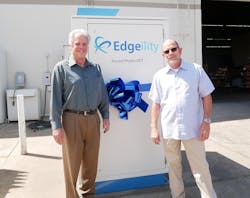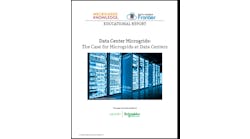Data center cooling startup Forced Physics Data Center Technology is entering the edge computing market, offering an outdoor server enclosure that can operate without water or traditional air cooling.
Forced Physics has deployed its first Edgeility System outdoors in Phoenix at Sun West Engineering, the manufacturer of the unit and first customer. The module can support up to 24 kilowatts (kW) of IT load, and operate at temperatures in excess of 110 degrees. The Edgeility unit is designed to run without liquid or server-level fans, with its only moving part being an industrial blower for enclosure-level airflow.
“There is tremendous value in an edge system that does not rely on liquid or air conditioning,” said Scott Davis, the CEO of Forced Physics and inventor of its core technology. “Our Edgeility System allows customers to compute anywhere – even the harshest environments. This is the breakthrough the industry needs to enable data collection closest to the source.”
The announcement brings another player into the market for edge computing solutions, which now includes regional data centers, startups offering micro data centers, cloud computing platforms, content distribution networks, and cell tower operators.
Forced Physics is positioning Edgeility as a solution for enterprise customers, who can add capacity by deploying the unit on a rooftop, parking lot, garage, or unused room. At 24 kW of capacity, the enclosure is smaller than many modules offered by edge specialists, which tend to be designed for between 48 kW and 256 kW of capacity.
“Any energy reducing technology in the high growth data handling environment is bound to grow legs,” said Phil McCoy, President of Sun West Engineering. “We were early supporters of Forced Physics because it’s something we believe in. We’ve worked with the giants in the telecom industry and know what it takes to build a robust enclosure for data center environments.”
Adapting its Technology For the Edge
The technology behind Forced Physics DCT has been in development since 2005. The company gained industry attention in 2019, displaying a data center module on the exhibit hall at Data Center World as well as a proof-of-concept installed at H5 Data Centers in Chandler. Its original pitch was for high-performance computing (HPS) and hyperscale operators, but it has expanded its target markets to include edge computing.
The company says its cooling system uses the movement of molecules to remove heat from a surface in an efficient and novel way. The speed of the movement of molecules creates heat energy, and the Forced Physics design focuses this movement to create a molecular beam, which creates a drop in temperature as beams of air are manipulated.
Over the past two years, Forced Physics has been adapting its cooling system to new form factors, including the Edgeility module. The company has reconfigured its JouleForce cooling conductor as a “microconductor” heat sink that can remove heat from processors or other components inside a server chassis. The exhaust heat is vented via a chimney atop the microconductor and into a chassis cover that doubles as a plenum, venting the heat out the back.
The Edgeility design uses a 23 OU (open unit) rack inspired by Open Compute Project designs. The customer chooses the IT gear, but the hardware is owned and operated by Forced Physics and rented “as a service” on a monthly fee, and serviced by partners. The current design uses a 24kW power circuit, but Forced Physics says it will adapt the design for other capacities as well.
For backup power, this unit has been configured with a rack-mounted sodium-ion battery from Natron Energy, rather than traditional lead-acid batteries or lithium-ion. Natron says its “better chemistry” uses Prussian blue electrodes to store and transfer sodium-ions faster and with lower internal resistance than other commercial batteries. Natron says its technology is particularly suited to edge applications and variable weather.
“Our battery’s unique characteristics such as wide operating temperature range, long life, safety, and sustainability are well suited for Edgeility System deployments in harsh
outdoor environments,” said Jack Pouchet, VP Sales for Natron Energy.
The Forced Physics solution requires no water, refrigerant or compressors, creating the potential for a simple design that eliminates expensive mechanical infrastructure. That creates the potential for excellent energy efficiency. But as with any new technology. market acceptance doesn’t happen overnight.
“This is radically different,” Davis told DCW in 2019. “It has to be demonstrated, so the industry knows that it works and it is safe. I think the main thing is education. It’s not a hard story, you just have to understand it.”






